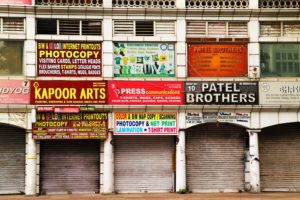Covid-19 & Indian economy

The subsequent extension of the lockdown can only spell the death-knell for many firms across the country (MIG photos/ Aman Kanojiya)
The additional moves by the Reserve Bank of India to ease liquidity in the markets in order to prop up the economy devastated by the coronavirus pandemic don’t address demand side issues.
On Friday, the Reserve Bank of India announced yet another fiscal relief package of close to INR 10 trillion (USD 130 billion) to further ease the liquidity in order to help the non banking financial services companies and micro-credit societies to continue lending. This relief comes on top of the first set of relief measures announced by the union government about 10 days earlier.
The initial package was released amidst much hype and with liberal use of hyperboles, as has become the norm with the current government. The relief package was purportedly worth about INR 17 trillion (USD 223 billion). However, closer inspection of the details revealed that nearly half the package comprised simply the measures already announced and accounted for during the budget presented in February. Thus, the measures announced to help the economy following the outbreak of coronavirus pandemic in India were worth less than 0.5 pc of the national GDP, a very miserly effort by the Indian government when across the globe, even the stingiest of governments have unveiled relief measures that go anywhere up to 17 pc of the total package.
Moreover, the government clearly underestimated the scale of economic disruption that the lockdown has brought upon the nation, especially the weaker sections, including small farmers, migrant workers and daily-wagers that could account for more than three-fourths of the national population. The relief announced for this section is a mere pittance. For instance, each woman with a bank account would receive INR 500 a month, in addition to some free rations. Clearly, India’s finance minister Nirmala Sitharaman did not take into consideration some ground realities that would expose this ‘relief’ as a joke. At a time when no one is allowed to step out and work or even look for work, how far can a family go on INR 500, even with some grains?
And even bigger challenge for the government and of course the people lies in actual implementation of even these entirely inadequate steps. Even two weeks after the first relief package was announced, residents in different parts of the country’s commercial capital, Mumbai, complained that they had not even received the regular supply of their monthly food rations, let alone any additional relief and of course the transfer of INR 500 to those women who actually had bank accounts was yet to reflect. A far greater number claimed that they did not even own bank accounts. Many of them say they are currently subsisting on the charity of others, having already gone though the small savings that they had managed to make.
If hundreds of thousands of people in Mumbai feel obliged to queue up for charitable food distribution, then the situation in rural and semi-urban India can hardly be imagined. Ever since the first relief package was announced, economists of all hues have been calling for the government to open its purse strings for the poorest and the weakest and to rapidly ramp up its miserly spending on healthcare where India figures even below Bangladesh in per capita spend. Hence, it was expected that when the RBI announced its own measures, they would go some way in addressing these issues. Indeed, by relaxing, though extremely little, the overdraft limits for state governments, the central bank has allowed them to enhance their social spending capacities. However, the states are already battling with historically huge deficits which have been made worse by a total drying up of all their direct revenues and with the central government not releasing their share of the Goods and Services Tax, the states find themselves at the limits of their fiscal capacities.
The situation across the country is bound to worsen dramatically in the weeks ahead. Despite nudges by Prime Minister Narendra Modi asking companies to pay full salaries to all workers and not to fire anyone during the covid-19 crisis, large-scale layoffs are already taking place across the entire spectrum of the economy. Most Indian businesses, especially the small and medium firms and the informal economy had already been hemorrhaging for nearly four years since the ill-conceived demonetisation and the flawed implementation of the GST. At the beginning of the year, the Indian economy recorded its slowest growth in nearly five years and not surprisingly unemployment rates in India also shot up to record heights in over four decades.
Thus, the lockdown and the subsequent extension can only spell the death-knell for many such firms across the country. Already, dramatic predictions about the scale of job losses as a result of the pandemic are emerging from across all sectors, with restaurants, tourism, aviation and white goods being the hardest hit, while the performance of even others like real estate, manufacturing and power would be disastrous, leading to tens of millions of job losses. Add to this the drop in farm income as well as other rural jobs could leave India staring at not just a recession, but tens of millions of people could be staring at starvation unless the government intervenes rapidly and ensures that each vulnerable family has not just adequate amount of food, but also money to be able to survive this year. And that would call for a much larger and better targetted relief package.









